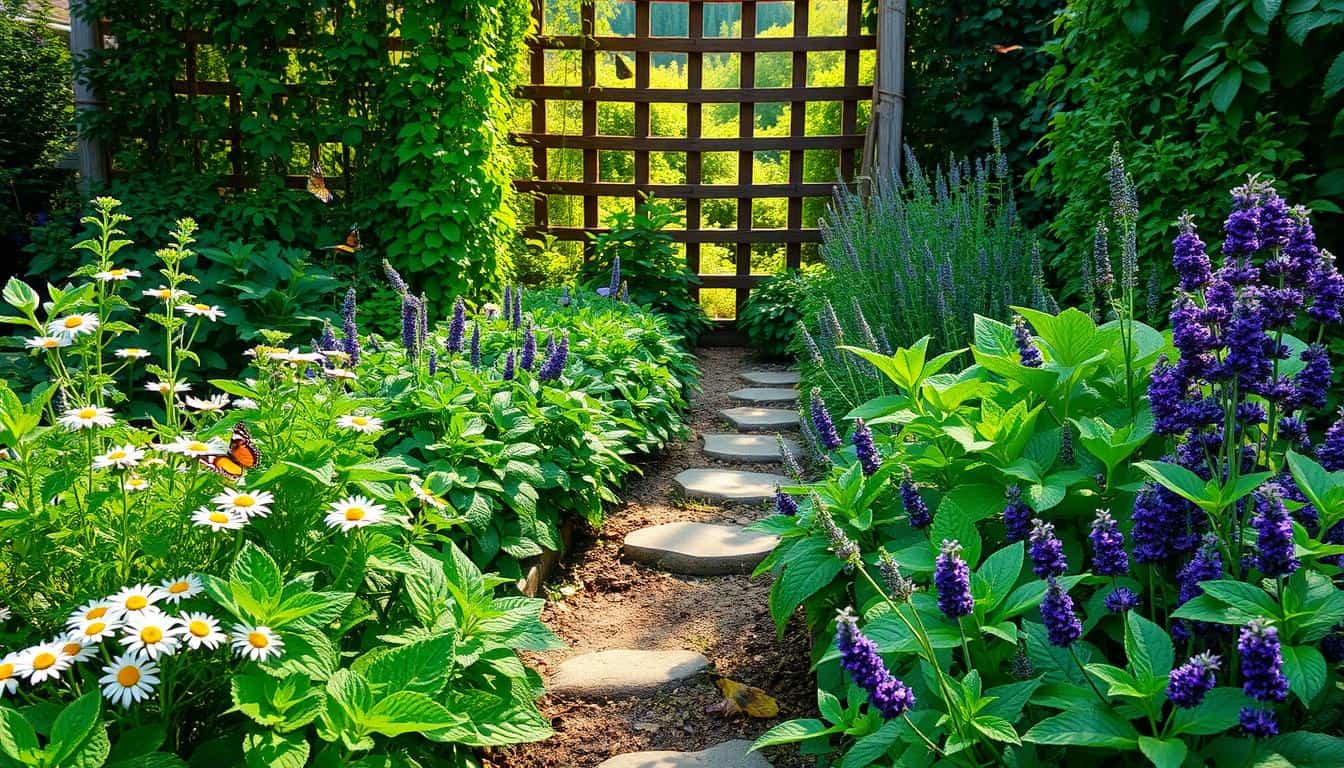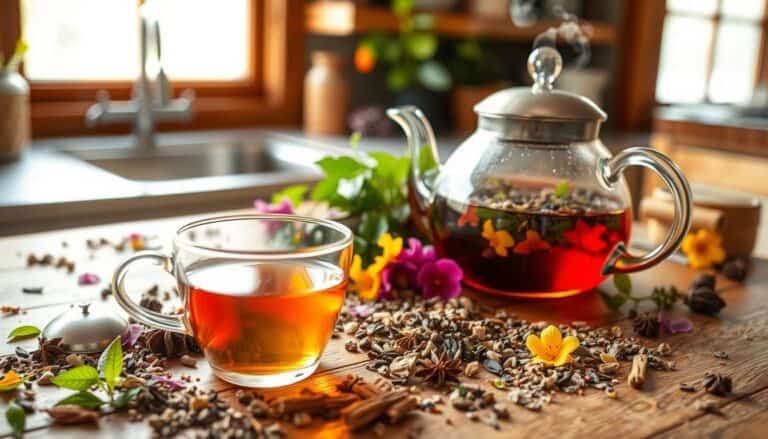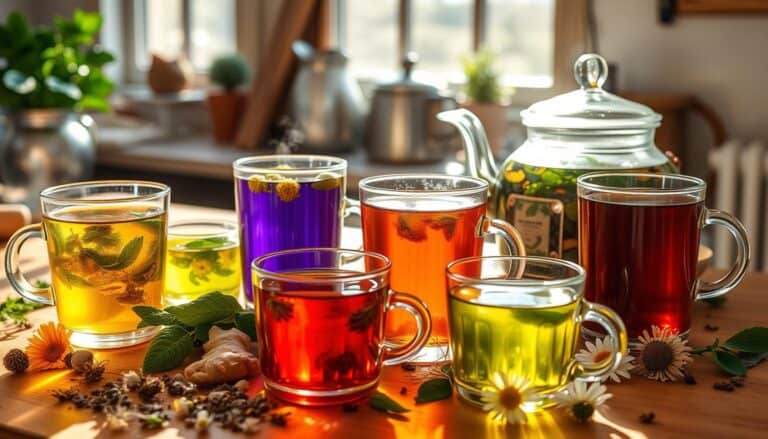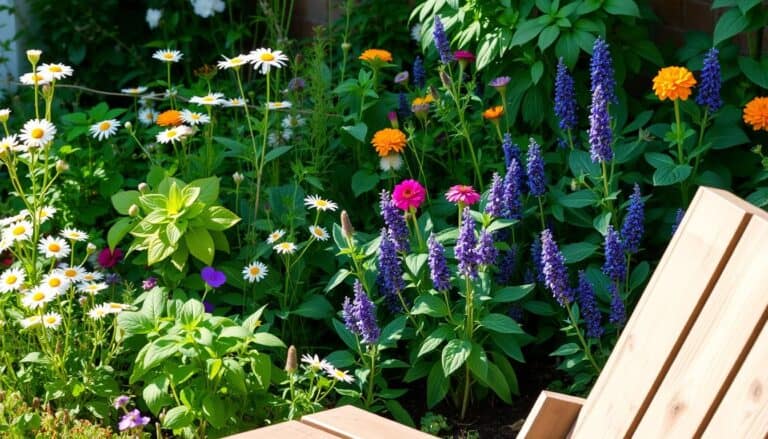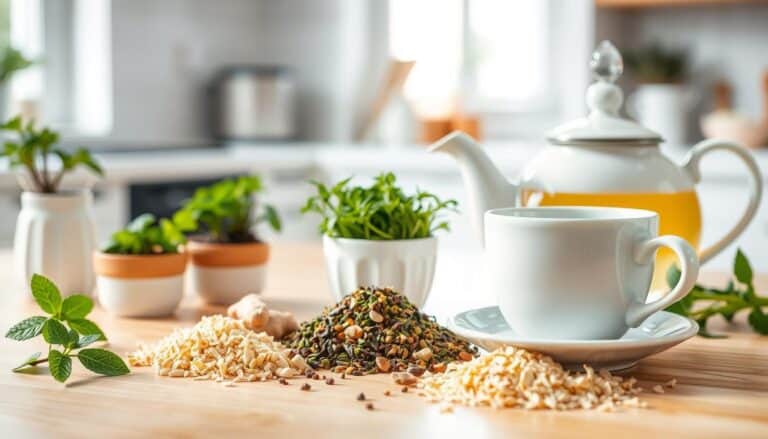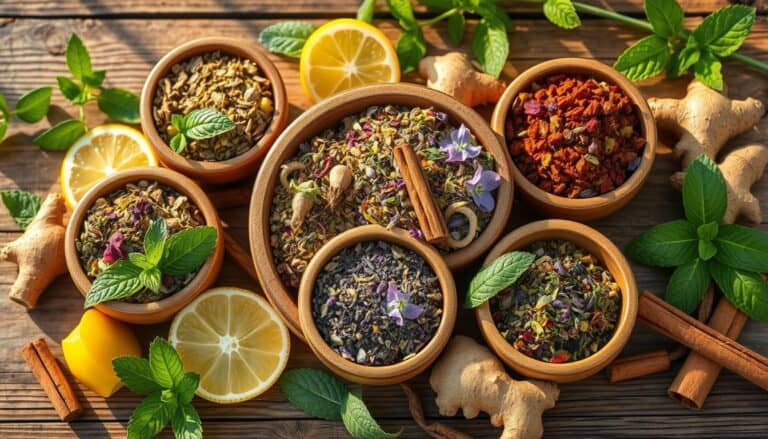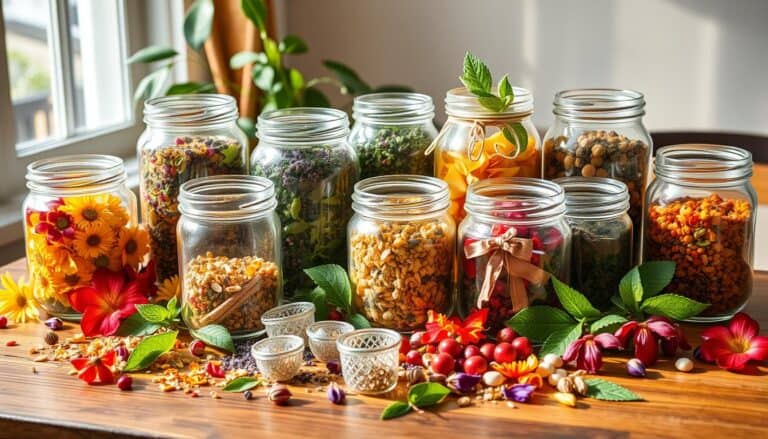Essential Herbs Every Tea Garden Needs
This post may contain affiliate links which means I may receive a commission for purchases made through links at no extra cost to you. I only recommend products I truly believe in. Thank you for your support!
Starting a tea garden is all about picking the right herbs. These herbs make ordinary drinks into special herbal teas. Gardening with herbs is a fun way to explore natural health and grow your own fresh herbs at home.
Tea garden herbs do more than just add flavor. They also have strong medicinal benefits and wonderful scents. Mint, chamomile, lemon balm, and sage are top picks for those who love growing herbs. They are versatile and add great taste to your dishes.
You don’t need a big backyard to grow medicinal herbs. Even a small windowsill can be perfect for them. You can grow these plants in pots, raised beds, or in the ground. This makes gardening with herbs easy for anyone.
Choosing the right herbs depends on your climate. Some herbs, like mint, grow fast and spread out. Others, like basil, need warm weather and lots of sunlight. Knowing what each herb needs helps your tea garden thrive.
Starting an herbal tea garden is a step towards better health and creativity in cooking. By carefully choosing and growing your herbs, you can make tasty, healing teas. These teas can nourish your body and soul.
Introduction to Tea Gardens and Their Importance
Creating a tea garden turns ordinary outdoor areas into magical places. These green spaces are more than pretty views. They connect us to nature’s healing power through garden herbs.
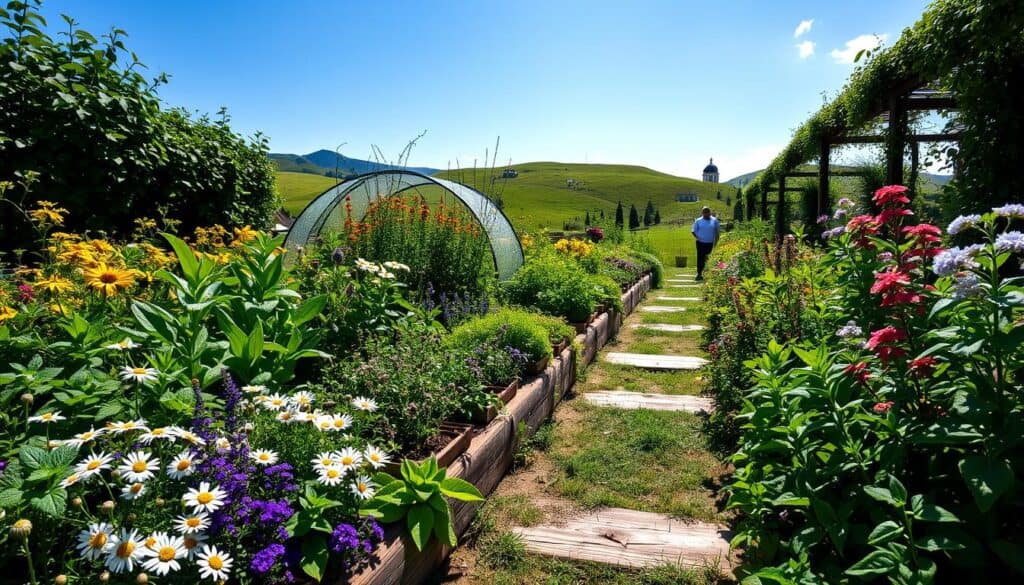
Tea gardens are special places where herbs grow for making tasty and healing teas. They can be small or big, each offering a chance to grow herbs.
The Concept of a Tea Garden
A tea garden is not just a bunch of plants. It’s a special place designed to grow herbs for tea. These gardens have many plants chosen for their taste, smell, and health benefits.
- Designed for herb cultivation and tea production
- Combines aesthetic beauty with functional growing spaces
- Allows personal selection of herbal ingredients
Benefits of Growing Herbs in Tea Gardens
Having your own tea garden has many benefits. It’s not just about having fresh herbs. It’s also good for your health, the environment, and your cooking skills.
| Benefit | Description |
|---|---|
| Fresh Ingredients | Get organic, pesticide-free herbs right away |
| Cost Savings | Save money by not buying herbal teas |
| Therapeutic Gardening | Reduce stress by caring for plants and connecting with nature |
| Custom Blends | Make your own special tea mixes |
Learning about tea gardens lets you turn your outdoor space into a lively herb garden. It’s a place that feeds both your body and soul.
Selecting the Right Herbs for Your Tea Garden
Creating a great tea garden starts with picking the right herbs. These herbs must do well in your area’s climate and soil. Knowing your local weather and soil is key to growing tasty herbs.
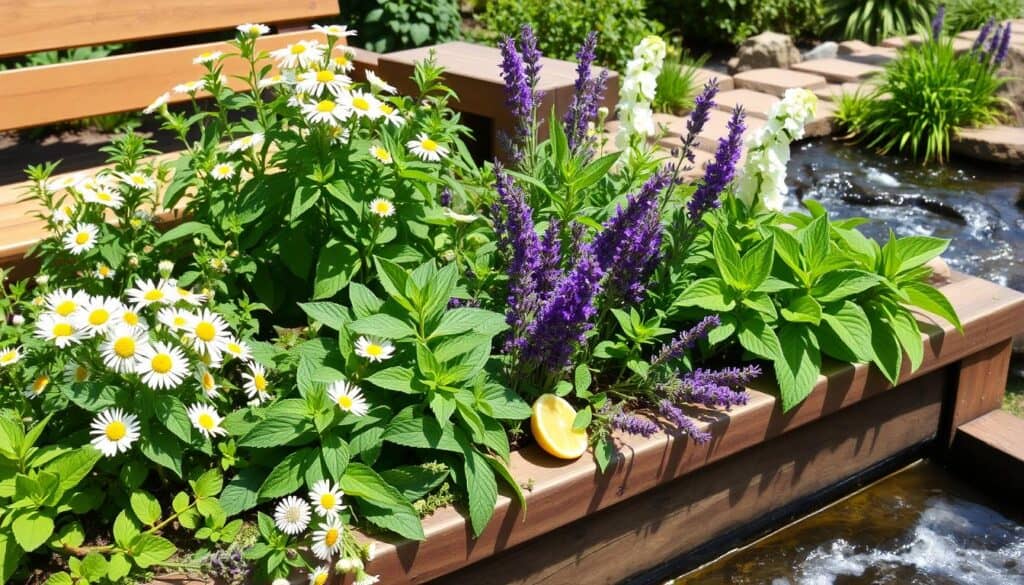
When picking herbs, think about flavor, how well they grow, and if they can handle your environment. A good mix of these factors will make your tea garden a success.
Climate and Soil Considerations
Herbs need the right conditions to grow well. Here are some important things to think about:
- Well-draining soil with neutral pH (6.5-7.0)
- Minimum 6 hours of direct sunlight daily
- Protection from harsh winds
- Consistent moisture without waterlogging
Types of Herbs Suited for Tea Gardens
Choose a variety of herbs to make your tea garden lively and productive. Each herb brings its own taste and health benefits.
| Herb Category | Characteristics | Best Growing Conditions |
|---|---|---|
| Mint Varieties | Refreshing, invasive | Partial shade, moist soil |
| Chamomile | Calming, delicate flowers | Full sun, well-drained soil |
| Lemon Balm | Citrusy, resilient | Partial shade, moderate moisture |
| Sage | Earthy, medicinal | Full sun, dry soil |
Pro tip: Plant perennial herbs for a lasting garden. These herbs come back every year, giving you a steady supply of tea ingredients.
Some herbs, like mint, grow fast. Use pots or special areas to keep them from taking over your garden.
Popular Herbs to Grow for Flavorful Teas
Herb gardening is a fun journey into growing your own medicinal and aromatic herbs. It’s rewarding to grow herbs for tea. You get fresh ingredients for tasty and healing drinks from your garden.
Mint – A Refreshing Favorite
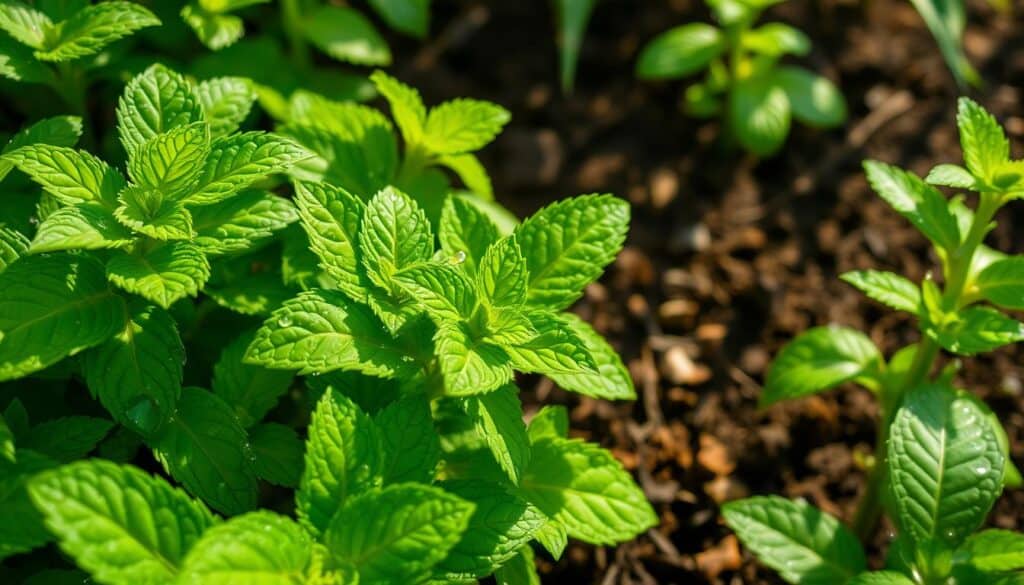
Mint is a top choice for tea gardens because of its cooling effect and flavor. You can grow spearmint, peppermint, or even chocolate mint. These herbs do well in different light conditions, from partial shade to full sun.
- Grows quickly in most garden environments
- Supports digestive health
- Provides refreshing flavor for multiple tea blends
Chamomile – The Calming Flower
Chamomile has delicate daisy-like flowers with a sweet, apple-like scent. It’s known for its calming effects and is easy to grow at home.
| Chamomile Characteristics | Growing Details |
|---|---|
| Height | 12-24 inches |
| Sunlight Needs | Full sun to partial shade |
| Primary Benefits | Relaxation, stress relief |
Lemon Balm – Citrus Notes in Every Sip
Lemon balm adds a bright, citrusy taste to herbal teas. Melissa officinalis grows about 24 inches tall and boosts mood. It’s a great choice for gardeners who want easy-to-grow plants.
- Helps with digestive upset
- Reduces nervousness
- Provides citrusy tea flavor
Herb gardening fans can try out these herbs to make unique tea blends. They can show off their garden’s best and their personal taste.
Medicinal Herbs for a Wellness Boost
Creating a wellness-focused herbal tea garden needs careful selection of powerful medicinal herbs. These herbs do more than add flavor. They offer natural health benefits that support your well-being.
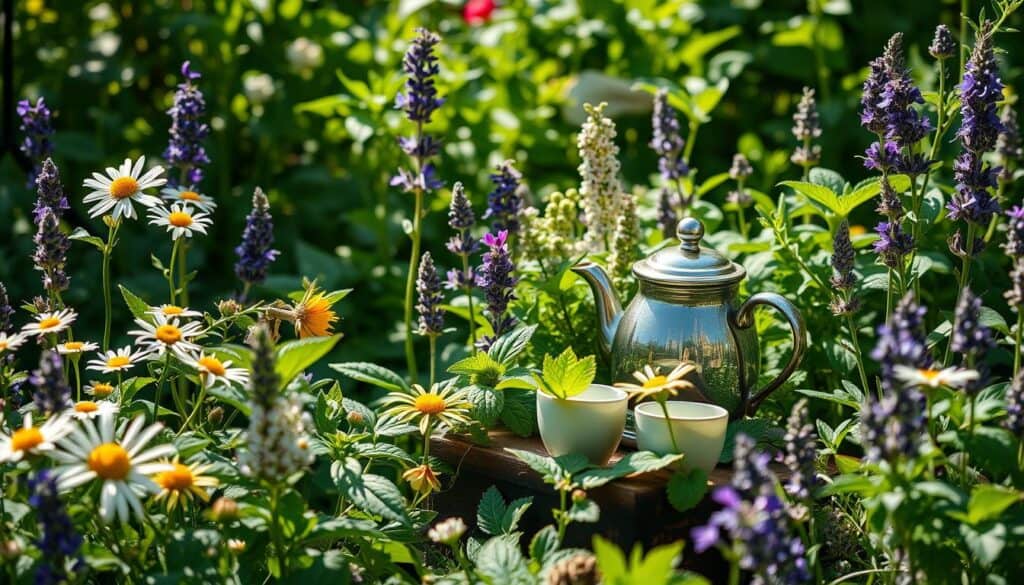
Echinacea – Nature’s Immune System Defender
Echinacea is a top choice for boosting your immune system. This plant grows stunning purple flowers and does well in many garden conditions. Gardeners love it for:
- Drought-tolerant characteristics
- Attractive visual appeal
- Potent immune system support
Making echinacea tea can boost your body’s defenses. It’s a key part of your herbal wellness toolkit.
Sage – A Digestive Health Champion
Sage is another key herb for medicinal tea gardens. It has a strong, earthy taste and health benefits. It helps with digestion and brain function.
- Supports digestive health
- May enhance memory retention
- Provides rich, complex flavor profile
Adding these herbs to your garden is a natural way to support health. Always talk to a healthcare professional before using herbs for medicine. This ensures safe and effective use.
Maintaining a Thriving Herb Tea Garden
Creating a successful tea garden needs careful attention and strategic care. It’s not just about planting herbs. It’s about growing a vibrant ecosystem that gives you flavorful and healthy herbs for your teas.
Best Practices for Herb Care
Herbs in your tea garden need special care. Knowing what each plant needs ensures they grow well and taste great.
- Water deeply but infrequently to encourage strong root development
- Prune regularly to maintain compact, bushy growth
- Avoid over-fertilizing, as most herbs prefer lean soil conditions
- Monitor sunlight exposure based on each herb’s specific needs
Integrated Pest Management Techniques
Keeping your tea garden safe from pests means using natural methods.
- Introduce beneficial insects like ladybugs and lacewings
- Practice companion planting to naturally deter harmful pests
- Use physical barriers such as row covers
- Inspect plants regularly for early disease detection
Some herbs, like lemon verbena and Roman chamomile, have special needs. Lemon verbena loves full sun and well-draining soil. Roman chamomile does well in partial shade. Knowing these details is key to a healthy garden.
By using these gardening tips, you’ll have a tea garden that’s strong and gives you fresh, tasty herbs for your teas.
Harvesting and Using Your Herbal Teas
Making the perfect herbal tea starts with careful harvesting. The right time is key to get the best flavor and health benefits. Morning is the best time to pick, when the plants have the most oils.
How you harvest matters a lot. It’s best to take only a third of the plant’s growth. This lets the plant grow back. For example, lemon balm is ready when it’s 6 inches tall. Mint needs at least four sets of leaves before you can pick it.
Keeping your herbs fresh is important. Dry them in small bunches in a warm, airy place. Use about one tablespoon of fresh herbs or one teaspoon of dried ones per cup. Steep for 5-10 minutes to get the most flavor and health benefits.
Trying new things is fun in herbal tea making. Mix different herbs to find flavors you like. Fresh tea is best within 12 hours. Iced tea stays good for 3-5 days in the fridge.
